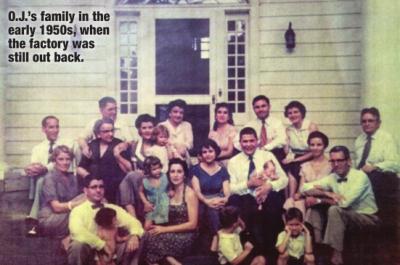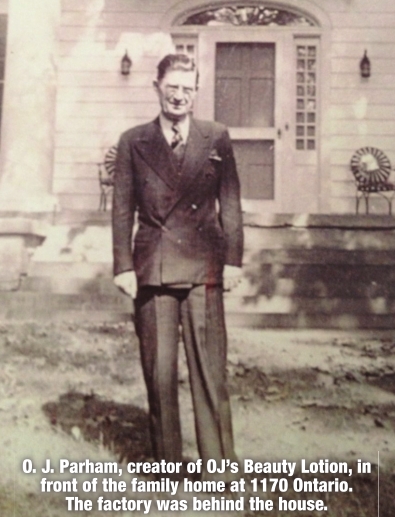OJ’s Beauty Lotion

Family business teaches work ethic, empowers women
What started as a prescription for facial blemishes became a pharmacist’s experiment, then a regional phenomenon, and finally, a family legacy. It was – the quick and easy way to beauty.
“You don’t really realize what your family is until you’re grown and get to look back on it,” said Jay Murrell, whose greatgrandparents, Minnie and O.J. Parham, created OJ’s Beauty Lotion. “Looking back, we can see how fortunate we were. We were comfortable. We were taught that people are people. No one ever looked down on anybody.”
OJ’s Beauty Lotion’s roots go deep – all the way back to 1901, when Minnie’s father took her to Dallas to visit a dermatologist to treat blemishes. After Minnie married O.J., her blemishes returned. So O.J., who was a pharmacist, created his own formula – 1/3 distilled water, 1/3 alcohol and 1/3 witch hazel, with some other chemical compounds.
“It worked,” Murrell said. “It had a drying effect. It was an astringent and a cleanser, and it also had a drying effect for her oily skin.”
 OJ’s Beauty Lotion was an effective cleanser, but it needed something more. To become a successful product, OJ’s needed Minnie as much as she needed OJ’s.
OJ’s Beauty Lotion was an effective cleanser, but it needed something more. To become a successful product, OJ’s needed Minnie as much as she needed OJ’s.
“Minnie was a natural entrepreneur,” Murrell said. “What she decided they needed to do was bottle it. So they did. They bottled it, and (O.J.) sold it in the drugstore he was working at.”
Shortly after that, in 1903, the Parhams moved from East Texas to Shreveport. O.J. began selling the lotion in Shreveport while they manufactured the product on the back porch of a rented house on Crockett Street.
O.J. Parham was not only a pharmacist. He could “sell iceboxes to Eskimos,” as Murrell recalls. Parham put his marketing hat on and went to work, creating promotional fans for OJ’s Beauty Lotion and painting billboardstyle murals on the sides of drugstores around the area.
The plan worked. Sales grew around the region. As sales grew, it became time for the company to grow again. In 1922, the Parhams moved from the rental house into a house they had built at the corner of Ontario and Richmond streets. The house included a twostory garage in back that became the new factory for OJ’s Beauty Lotion.
The Parham family also was growing, and so was the family’s role in the business.
“It was an omnipresent aspect of our lives,” said Catherine Davis, Murrell’s sister. “We grew up playing in the factory behind the house on Ontario. It’s still in the family today.
“As children, we kids would go out and explore. It was a fun neighborhood to visit. We were there quite often. Our family was structured around family first and then OJ’s. There was not a big space between the two. So many family members worked there directly or indirectly.”
Murrell, who worked in the factory during the summer growing up, said the product became very popular, especially in the humid South.
“I remember in the summertime coming home and just pouring a bunch into a towel and rubbing my face and neck with it,” he said. “When you took the towel away, it was just gray with grit.”
The family moved production of OJ’s Beauty Lotion into a stand-alone factory in 1956. That’s also when Minnie and O.J.’s daughter, Sybil Parham Barnette, took over running the plant.
“She was the original feminist,” Murrell said of his grandmother. “She could do anything a man could do in terms of managing the logistics of the operation.”
Barnette was passionate about every aspect of the business, too, Davis said. She recalls that the factory was painted a color the family called “Barnette Green” because Barnette found the color to be calming and soothing.
“Grandmother was an artist,” Davis said. “She started as a painter. Then she felt she needed to help with business. She had an artistic eye in the way she set factory up.
“She took tours of other factories. She went to the Tabasco factory on Avery Island. They bottle a liquid, too. She used a lot of those ideas.”
Davis said she was only 5 years old when the factory on Florence Street opened. But she holds vivid memories because of the amount of time she spent there growing up.
“It was not an air-conditioned factory,” Davis said. “But it had excellent ventilation and fans to circulate the air. It had huge doorways that trucks would back up to. It had a lot of air circulation. It felt busy and efficient, but uplifting at same time. (Barnette’s) office was on mezzanine. She could look out and see everything going on. It was sort of her royal throne up there.
“When we’d go to visit, we’d go up these steps. She was quite concerned with safety and security. I remember the sound of the footsteps echoed around the factory space. We’d do that, and there was a fridge on ground floor filled with Coca-Cola. She thought that was a wonderful company.”
Murrell said he recalls two times the company tried to expand its product line.
“One was a shampoo,” he said. “This was back in the teens. I remember my cousin Phil and I found a case or two of it. It had viscosity of motor oil. There was a playroom, and I remember there was this huge round table up there. We were like 6 years old. We poured it out on the table and skated around on it.
“Then, in the ’60s, we tried a men’s product. It was an astringent/cleanser, too, with kind of a manly scent. It didn’t really take off.”
Barnette ran the Florence Street factory until 1985. She was 82 years old when the family sold OJ’s Beauty Lotion to Goody’s, a consortium out of North Carolina famous for its headache powders. Goody’s produced OJ’s Beauty Lotion for about 12 more years before shutting the product down, Murrell said.
For Davis, Murrell and the rest of the family, the experiences, memories and legacy of OJ’s Beauty Lotion live on in a variety of ways, include bottles of the product with Davis’ face on them.
“I love to talk about it, because it’s my heritage, and I am very proud of it,” Davis said. “I also probably have largest collection of old bottles and memorabilia on the planet. My brother and I are the last living people to tell the story. So, of course, we tell it if anyone is interested.”
“It put a lot of kids through college,” Murrell said. “It provided a comfortable living. There are some assets original to OJ’s that are still in the family and still produce income. It’s a nice little legacy.
“What it did, though, it taught us a work ethic. It was our model for entrepreneurship, hard work, always doing next right thing and telling the truth.”
Davis said the impact her grandmother had on her was even more profound.
“As a girl at the time growing up into a woman, the strong message I got because they were businesswomen, was a woman could do whatever she wanted,” Davis said. “That’s not what most of the mothers of my friends had as an example.”
Murrell said their great-grandmother deserves all the credit.
“Minnie Craig Parham was an amazing woman,” he said. “She’s the one who made it work. Her husband was the salesman, but the reason it existed was because of her. She was amazing.”
